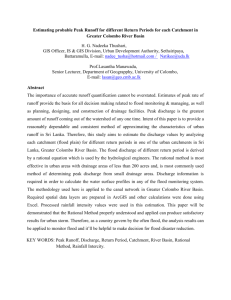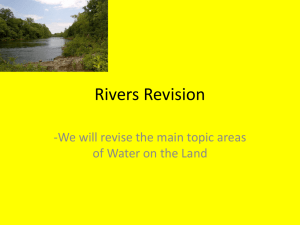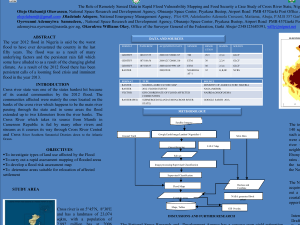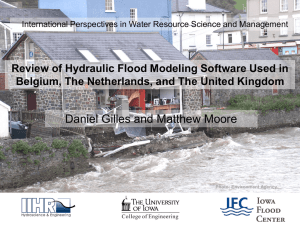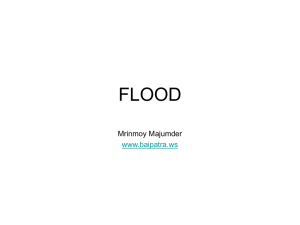6.13 Case Design Experiences in Tigray
advertisement
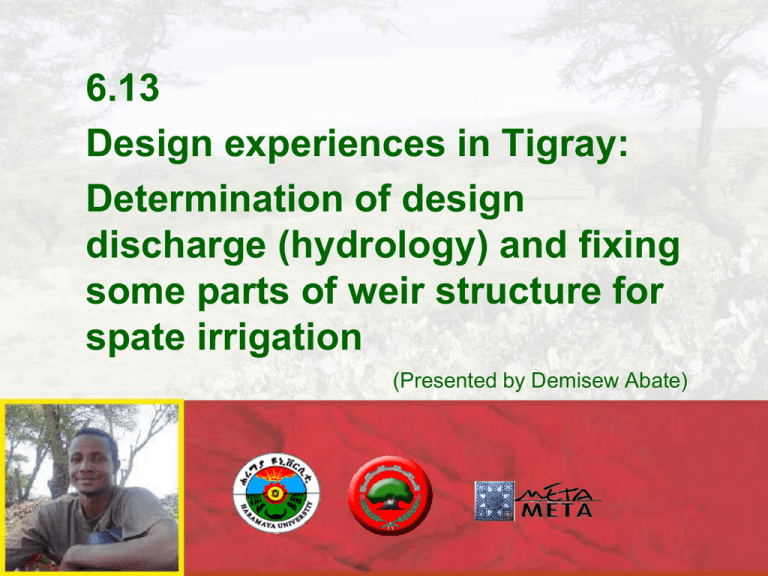
6.13 Design experiences in Tigray: Determination of design discharge (hydrology) and fixing some parts of weir structure for spate irrigation (Presented by Demisew Abate) 1. Hydrology The availability of reliable data for any engineering design is vital. Hence before any design is started any available data need to be collected. `` For most project in raya valley area the available metrological data from proximate station is selected Such as highlands of the valley (from Maichew, korom and chercher) metereological stations. continued 1.1 Rainfall The rainfall of the project area is bimodal type where small rains occur during the month of febApril, representing the beleg season and big rains occur during the month of july to September, farming the main rainy season known as Keremt. continued 1.2 stream flow records In these projects the actual record of river runoff is not available therefore the estimation of runoff volume has been done for each month based on the available rainfall record from the nearby metreological station In case of absence of the recorded data ,the estimation of peak river flows makes more difficult and challenging. in order to adopt the best estimate for the design of hydraulic structures different empirical formula, which correlate catchments size and land cover, slope, soil texture etc. and rainfall parameters are used. continued Even though formulae, which maximize measured input parameters, are believed to simulate the local situations, in the absence of such measured data formulae developed for local situations shall be given priority. Therefore, using the following methods carries out design flood estimation for this project. continued I ) Flood estimation by Tekeze basin formulae from the empirical formulae developed for Tekeze basin q = 33.33 A-0.609 Where q = discharge intensity in m3/sec/km2 A = Catchment area in km2 continued 2) Flood estimation by Dr. Admasu method based on the empirical data developed by Dr. Admasu for the Ethiopian highlands. Q = Cf Qmd Where Qmd = 0.87*A 0.7 Cf = 1 + 5*A-0.2 continued iii ) The composite hydrograph method (which is developed by the US corps of Engineers).(DesignExperiencesTigray\SCS method) employs the rainfall pattern of the catchment’s area as well as the catchment’s characteristics as its major input parameters to predict the design discharge for recurrence interval of 50 years. iv ) Historical Maximum Flood The Maximum historical flood occurred at the site is determined from flood marks and information obtained from the near by people and there is a clear flood mark at the bank of the river. In order to estimate the historical maximum flood ,a cross-sectional survey of the weir axis’s was made. From the crosssection ,total area of flow was determined Applying the well-known slope area method of estimation, the maximum flow continued The Manning equation is usually used to compute discharges from water level, cross section(s), the water surface slope, (often assumed to be the same as the bed slope) and an estimated Manning roughness coefficient, which for wadis with coarse bed material is often taken as 0.035 or 0.04. Calculations are carried out for a reasonably uniform and straight wadi reach, located close to the actual or proposed intake continued Sites should be selected using the following criteria: Local information is used to make a reliable estimate of the water levels observed during a historic flood at the site. The length of reach should be greater than or equal to 75 times the mean depth of flow. The fall of the water surface should exceed 0.15 m from one end the reach to the other. continued The flow should be confined to one channel at the flood level with no flow bypassing the reach as over-bank flow. Application of the flow resistance equation requires that the bed should be largely free of vegetation and that the banks should not be covered by a major growth of trees and bushes Sites with bedrock outcrops should also be avoided. continued It is difficult to satisfy all the above criteria and some compromise is usually necessary The maximum flood water level is levelled to the same datum used for the cross sections surveys. Calculations can be carried out using the Manning equation: Q = (1/n) x A x R0.67 x S0.5 continued where Q = discharge, m3/s A = Cross sectional area of the flow, m2 R = Hydraulic radius, A/P, where P is the wetted perimeter of the cross section, m S = the slope of the channel n = Manning roughness coefficient Mannings coefficient is tabulated for a range of channel conditions in most hydraulic text books For Wadis with coarse bed materials it is often taken as 0.035 or 0.04. Continued In spate irrigation system, the amount of runoff that has to be diverted should be consistent with the scheme size to be developed. - Moreover, the irrigation infrastructure may not be used fully in all months; the reason is that there is a variation in the amount of diverted flood. Therefore, the appropriate estimate of the flood can be handled with optimum cost of the project . This can be described in terms of the ratio of diverted discharge to the total river flood. Continued The runoff diversion ratio designated by η assumed to be determined by referring to the already established value of other countries by considering the actual condition of valley into account. - According to the local condition of the valley and efficiency of our users the size of the most spate irrigations scheme determined for the rainy season is based on the runoff diversion ratio of η = 0.55. continued Therefore, the using the diversion ratio and the monthly flows computed command area to be supplemented is fixed. And accordingly the canal sizing is also done using this flood. 2.Canal discharge In the previous section the total runoff volume needed to be diverted is determined on the basis of runoff diversion ratio. Then this volume of runoff with in the month should be changed to discharge per unit time. and this discharge is the design flow that is used for main and secondary canals. Since in most of our projects the actual record of river runoff is not available and the diversion discharge or the design discharge estimated with the following empirical formula. continued Q=Qk. η (A/(B- η)) …………** Where Q = design discharge in m3/sec Qk = 10 year return period peak flood in m3/sec. (mean annual) A, B = constants η = runoff diversion ratio Continued In the area where the flood record data is available the constant A and B can be determined by curve fitting method. But in areas with no record data the value of A and B estimated from empirical value given which depends on the flow characteristics of the river runoff. In general, for rivers with much uneven runoff where the flow pattern shows quick rise and fall of short duration the value of A ranges between 2.1 and 2.4 and B equals 1.05. Similarly for rivers with relatively even flow pattern value of A ranges from 2.5 to 2.9 and B equals 1.0. continued Now calculate the value of Qk This is done by the studies conducted by Dr. Admasu on flood frequency analysis of required nature yielded the following formula for stream and rivers situated in Ethiopia Qmax = 0.87 * A0.7 Continued Where Qmax = mean annual flood discharge in m3 A = drainage area in Km2 The required design flood with specified return period will be as follows QT = Qmax * Qt where QT = T-year return period Qt = Flood growth factor ( 2.0 for 10 year return period) Continued But Practically there is low frequency and duration of flood and experiences have shown us that this discharge is too small to compute for canal sizing therefore based on the this fact we simply provide some allowances on the calculated discharge for (sizing structure in consultation with the farmer ) 3. under sluice The purpose of the provision of under sluice is to provide silt free water to the intakes and to flash the silts through them before every first rain splash of the season. However the farmers are not willing to loose a drop of water even for flashing and their interest is to have no under sluice gates. The under sluice is designed to pass 10 – 20% of the peak flood. Mostly we provide bays of each 0.90 x 1.0m opening of sluice gate. This is made for simplicity of operation. 4. Off takes Previously we provided large diameter pipes off takes which are gated and with diversion angles of 900 but this pipes were silted up and could not serve for more than a year. Off takes… The farmers are very well experienced and as the discussions held with them the off takes are now open channels and the off take angles are now 120 – 1500 according to the interest of the farmers and the river nature. Design of weir (HW) for Spate Irr. Sample report (Hw, Infrastructure, Specification and working drawing ) Design ExperiencesTigray\Diversion, DesignExperiencesTigray\MAI AKINO HEAD WORK DR.dwg Thank U
